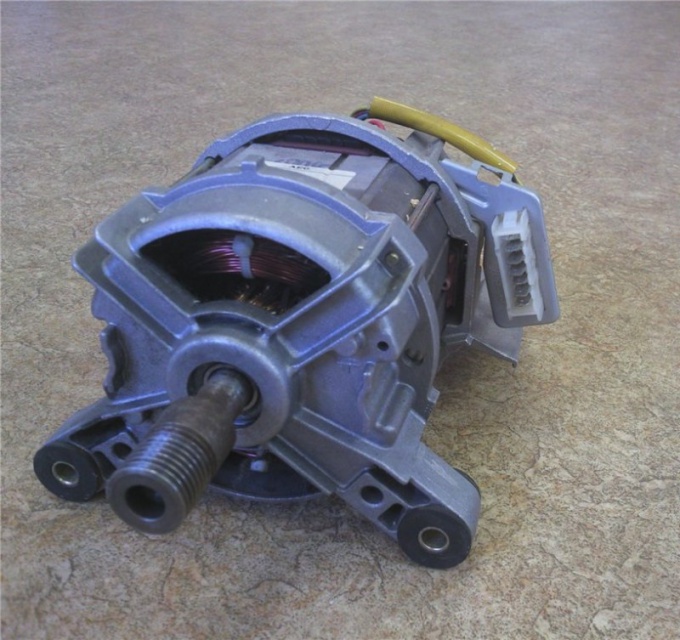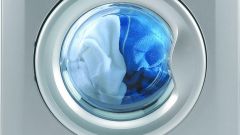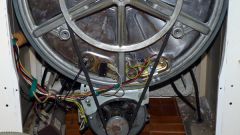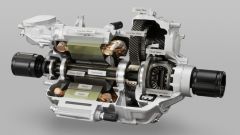In washing machines can be used two types of electric motors. The first - brush commutator motor with windings for additional excitation. Such electric machines are installed in the belt rotation transmission from the motor to the drum. Stepless regulation of rotation speed is performed by applying a voltage of different magnitude in the auxiliary winding of the stator. In washing machines with direct drive uses three phase motors with a rotor with permanent magnets and multi-pole commutator stator. In these, the speed change occurs due to the involvement of a greater or lesser number of poles or by changing the frequency of the current in the feeding three-phase network.
In washing machines the engine is located at the bottom of the device from the back side. To access the repair area it is necessary to remove the inspection cover by removing a few screws. In machines with a belt drive motor is attached to the metal frame using studs or bolts. Electrical connection is made via quick connect terminals. Motors in machines with direct drive have a more complex structure, as it is itself part of the washing tank. Their stator is bolted to the chassis of the washing machine, the rotor has a rigid attachment to the basket, which is often permanent. That is why the engine must be removed along with the tank.
In most cases, the test engine from the washing machine with direct drive it is impossible to produce without special laboratory bench and equipment. The best way to locate the fault in this case is the service menu of the machine or frequency Converter, which can change depending on the model. The error code displayed on the display, it is possible to diagnose short circuit, breakage of the mains, the brushes wear and other problems.
In most cases, disconnected the engine has a group of several wires, including: the beginnings and the ends of the windings of the stator and rotor, and wire the control circuit. To check the health of the engine should be connected in series stator and rotor, thus apply for all mains voltage via additional ballast, which can be ten or more active resistance, having the electric capacity of at least 500 watts. If there is a rotation of the motor in normal mode and there is no strong heating of the ballast, then the probability is high that the engine is all OK and the coil is not broken. The reason may be in a strong wear of the brushes or damaged collector, breakage of the control wires or a faulty Tacho. Such malfunctions can be determined only when complete disassembly of the engine.
Removing the engine from the washing machine
In washing machines the engine is located at the bottom of the device from the back side. To access the repair area it is necessary to remove the inspection cover by removing a few screws. In machines with a belt drive motor is attached to the metal frame using studs or bolts. Electrical connection is made via quick connect terminals. Motors in machines with direct drive have a more complex structure, as it is itself part of the washing tank. Their stator is bolted to the chassis of the washing machine, the rotor has a rigid attachment to the basket, which is often permanent. That is why the engine must be removed along with the tank.
Check multi-pole three-phase motor
In most cases, the test engine from the washing machine with direct drive it is impossible to produce without special laboratory bench and equipment. The best way to locate the fault in this case is the service menu of the machine or frequency Converter, which can change depending on the model. The error code displayed on the display, it is possible to diagnose short circuit, breakage of the mains, the brushes wear and other problems.
Check commutator motor
In most cases, disconnected the engine has a group of several wires, including: the beginnings and the ends of the windings of the stator and rotor, and wire the control circuit. To check the health of the engine should be connected in series stator and rotor, thus apply for all mains voltage via additional ballast, which can be ten or more active resistance, having the electric capacity of at least 500 watts. If there is a rotation of the motor in normal mode and there is no strong heating of the ballast, then the probability is high that the engine is all OK and the coil is not broken. The reason may be in a strong wear of the brushes or damaged collector, breakage of the control wires or a faulty Tacho. Such malfunctions can be determined only when complete disassembly of the engine.



